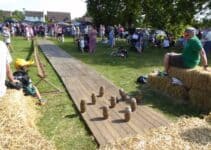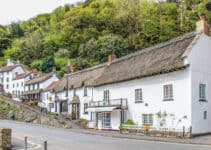England is populated with hundreds of towns and cities, and thousands of villages. It’s easy to draw the line between these based on large population sizes, but what about smaller populations?
Below, you’ll learn about 8 of the smallest villages in England based on either population size or area. Before jumping into the list, we must first consider what actually makes a small village.
What Counts as a Small Village?
We won’t go into too much detail here, as we have a separate article on the full differences between a village and a hamlet. In short, a hamlet is a small village that typically doesn’t contain a church, village hall, or pub.
But this doesn’t relate to population sizes and isn’t a particularly clear legal definition. As such, the small villages below aren’t the absolute smallest settlements in England – these can be just a few houses.
Instead, these are settlements we could easily classify as villages: they have a notable population size and, by extent, the type of amenities you’d find in a village.
You’ll therefore definitely find smaller settlements in England (and the rest of the UK), but these tread the fine line between hamlets and villages.
What are the Smallest Villages in England?
1. Lacock, Wiltshire
With a population of around 1,100, Lacock in Wiltshire is a pretty large small village. However, it’s worth mentioning as a special case because of its important position in English history.
Lacock is almost entirely owned by the National Trust, making it technically a private village. It can trace its history back to the Domesday Book, but most of the surviving buildings date from between the 14th and 18th centuries.
It has 2 Grade I listed buildings – the church and a tithe barn – and 4 Grade II listed buildings as well as a Victorian school.
Lacock’s main modern claim to fame is as a filming location. If you see pictures of its main street and iconic buildings, you might recognise them from media such as Pride and Prejudice, Harry Potter, Fantastic Beasts, Downton Abbey, and the 2017 remake of Beauty and the Beast.
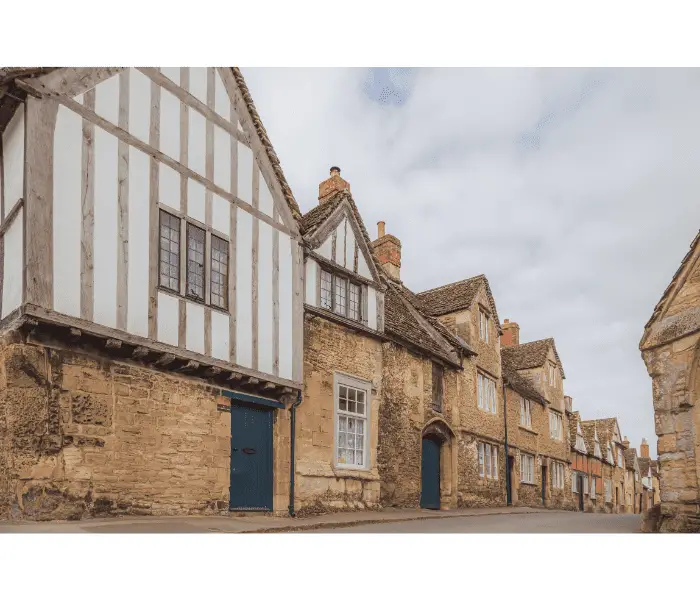
2. Whitwell, Rutland
Located in the smallest county in England, Whitwell has one of the best claims for the smallest village in the country. In the 2001 census, its population was a tiny 41 residents.
It consists of around 19 houses, a church and a pub. Based on the definition above, this is why it’s a village and not a hamlet.
These buildings are spread across less than a square mile, making Whitwell small in size and population.
However, it’s got a pretty impressive claim to fame. Whitwell is twinned with Paris, France and has been since 1980. Regulars at the pub wrote to the mayor of France suggesting it.
After they didn’t receive a response by the deadline, they went ahead and erected the signs, and that was that!
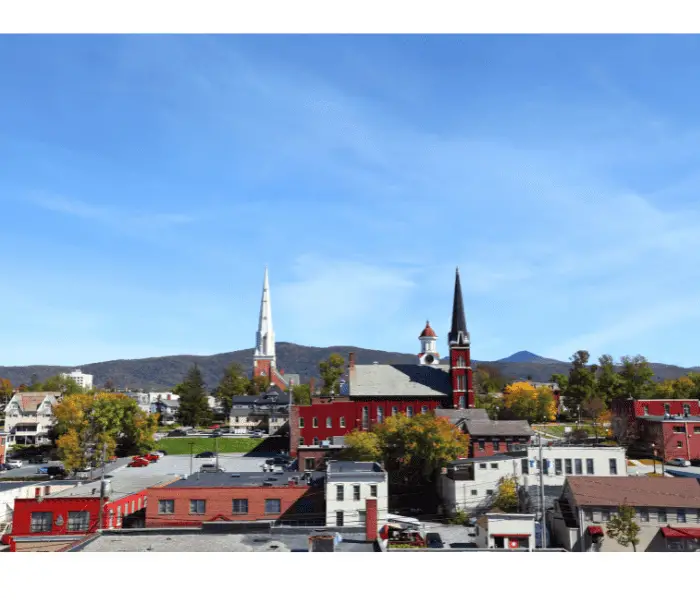
3. Kersey, Suffolk
Kersey in Suffolk has a population of around 350 residents. While it’s not the smallest village in the country, it’s arguably one of the most picturesque.
It has some amazing timber-framed buildings, including the Bell Inn, which was built in 1378.
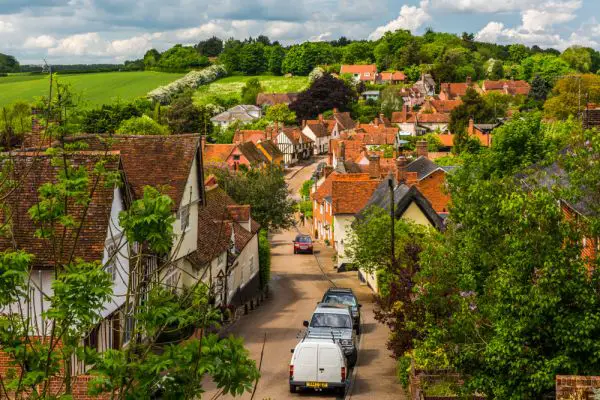
Although it’s now a sleepy tourist village, Kersey was very famous during the Middle Ages. It was home to kersey cloth, a coarse wool fabric that was a major component of the English medieval textile industry.
While it was made across the country, its name is believed to derive from Kersey village.
4. Priors Hardwick, Warwickshire
In the 2011 census, Priors Hardwick had a population of just 172 residents. This is significantly less than in the 1801 census when it had a staggering population of 228!
Priors Hardwick was traditionally an agricultural village, and its oldest central buildings date from the 12th century onwards.
Its most impressive building is the Grade II listed parish church, St Mary’s, which has parts dating back to the 12th century. There’s also the old pub, The Butcher’s Arms, which is believed to date from some time in the 14th century.
Priors Hardwick’s main claim to fame is as a stop on the drover’s road known as the Welsh Road.
Unsurprisingly, this is the route drovers (cattle herders) took from South Wales to London. It even had an influence on the naming of local landmarks; the pond near the village is called Cowpool.
5. Clovelly, Devon
Clovelly parish has a population of around 450, although the village itself only has about 300 residents. It’s built into sea cliffs, meaning the main street is very steep (and free from cars).
The only way to move stuff around in the past was to use donkeys, although these have now mostly been replaced with motorised sledges.
Clovelly is privately owned by a single person – John Rous. His family have been the owners and managers since 1738, and it’s been passed down through the generations.
Before then, it only had 2 previous family owners, which is a fairly impressive record considering it’s been privately owned since the 13th century.
Traditionally, Clovelly was a fishing village, but its main focus now is tourism. It attracts quite a large crowd in the summer thanks to its old-style architecture and unique placement on a cliff.
If you decide to visit, make sure you’ve got some good walking boots!
6. Hexton, Hertfordshire
Hexton, in Hertfordshire, has a population of around 120 residents. It stands out in English names due to its inclusion of an X, which has never been a particularly common letter in the English language.
Originally named Hegestanestone, it mutated into Hecstone and into Hextone by the 15th century. There’s no clear explanation of what its name means, but it’s believed to derive from a person’s name (Heahstane) and the area was their farm.
The village features Hexton Manor, a modernised mansion, and an Iron Age fort called Ravensburgh Castle. It’s believed to date from around 400 BC and was an important monument in the local area for nearly half a millennia.
7. Great Snoring, Norfolk
If there was an award for memorable place names, Great Snoring would be a top contender. With a population of around 150, it’s also a top contender for a small English village.
Interestingly, its name actually has nothing to do with the noise people make when they sleep. It comes from an Anglo Saxon name, Snear, which mutated into Snaringa and then into Snoring.
The village was traditionally known as Snoring Magna, the Latin word for “great”.
Its most notable buildings come from the 15th to 19th centuries, including its old manor house and parish church.
The Old Rectory, its manor house, dates back to the 15th century but has parts from the 17th-19th centuries. Built entirely from brick and terracotta, it’s a particularly impressive building.
8. Skeffling, Yorkshire
In 2011, Skeffling had a population of 149, making it a suitably small English village. It’s not entirely clear what its name means, or whether it’s Anglo Saxon or Scandinavian in origin.
It could possibly mean spear shaft or “creation”, although it’s not clear what either of these has to do with the village.
Skeffling doesn’t have many notable landmarks, other than a Grade I listed parish church built in the 1460s. It was built in the traditional cobblestone design that was popular in the period.
Where is the Smallest Village in England?
The smallest village in England is most likely in Rutland, specifically Whitwell mentioned above. While there are perhaps smaller settlements that count as villages, it’s difficult to decide whether these count.
Generally, smaller “villages” are part of larger settlements, such as towns and cities. We can’t really classify them as small villages in their own right because there aren’t clear boundaries defining them.
Smallest Village In The UK
Also, there are definitely smaller villages in the UK, such as Church Bay in Anglesey and Knocknagulliagh in Co. Antrim, Ireland.
But you can probably see the issue here: they’re not in England. Considering England is the focus of this article, we can’t really include them.
Smallest Villages in England
The smallest villages in England generally have a population of less than 1,000. While this isn’t a strict rule – and doesn’t sound very small in isolation – they’re a lot smaller than the largest villages.
As we discuss in another article, large villages can have populations of nearly 20,000 residents! When you look at it this way, a village with a thousand or fewer inhabitants definitely sounds much smaller.
The only real exception to this rule would be somewhere like Lacock. We included it on our list of the smallest villages because it deserves a mention thanks to its important place in modern British media.
While it’s not a specifically small village, it’s certainly noteworthy.
Smallest Villages in England
Hopefully, this list of the smallest villages in England will give you some inspiration for where you could visit on a historical road trip.
Generally, small English villages retain a lot of their old-school charm, making them great places to simply become absorbed in traditional architecture and history.
